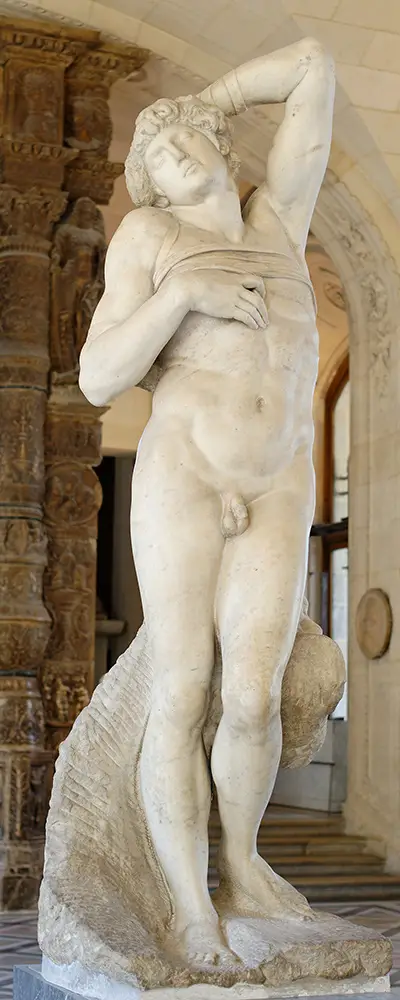The Louvre holds another of Michelangelo’s sculptures, “Rebellious Slave”. They were both produced as part of his work on the revised plans for the tomb of Pope Julius II, commissioned from him in May 1513.
They were intended to be two of a number of “Prigioni”, or Prisoners, that would have appeared on the lower level of the tomb had they not been removed from the plans for the final version completed in 1545. It was only in the nineteenth century that these works came to be called “slaves”.
Michelangelo later presented these two sculptures to Roberto Strozzi in gratitude for his generous hospitality. Michelangelo had stayed at Strozzi’s house in Rome during his periods of sickness in 1544 and 1546. Strozzi took them with him to France, when he was exiled from Italy, and they eventually became part of the French national collection in 1793.
Michelangelo’s initial training was as an artist. At the age of thirteen he was apprenticed to the workshop of Domenico Ghirlandajo, one of the leading artists in Florence at that time. Here he would have gained a good education in the techniques of the painting of frescoes and draughtsmanship.
However, Michelangelo spent only one year in the workshop of Ghirlandajo before being sent to the palace of Lorenzo de’ Medici. He was there able to learn from the sculptor Bertoldo di Giovanni and study the works of Giotto, Masaccio, Donatello and those of the Greek and Roman sculptors to be found in the Medici collection.
He learned all he could from the ancient sculptors of how to represent the muscle and sinew of the human body in motion. Not content with learning anatomy from the works of others, Michelangelo drew directly from live models and, with the permission of the Catholic Church, even dissected bodies to gain a deeper understanding of the human form. Michelangelo became expert in portraying the human body in all its variety of movement and posture. He was soon acknowledged to be one of the outstanding artists of his age, not only equalling the masters of classical antiquity but even surpassing them.
It was in 1505 that Pope Julius II commissioned Michelangelo to build his tomb in Rome. It was an ambitious, grandiose, project, designed to reflect the power and glory of the ruler of all Christendom and which was intended to include forty large statues. It is not difficult to see the attraction, for a man of Michelangelo’s artistic ambition, of working for a great prince of the church whose ambitions matched his own and who had the means to realise them.
Michelangelo travelled to Carrara in order to oversee the selection of the marble for the project. He spent six months or more there selecting, rejecting and purchasing the great blocks of marble from which he would build the mausoleum. But the Pope had other projects, such as building a new St Peter’s and military campaigns, to fund, and his enthusiasm for the tomb had seemingly cooled by the time Michelangelo had returned to Rome. Michelangelo left Rome in frustration and it was only when Pope Julius II put diplomatic pressure on the City of Florence that he returned, from there, to Rome.
On his return, however, Michelangelo was instructed to work, not on the tomb of Pope Julius II, but on a fresco for the ceiling of a chapel that had been built by Pope Sixtus IV; the Sistine Chapel. It is suggested that Michelangelo tried hard to avoid this commission for a fresco on the grounds that he was not really a painter at all, but a sculptor. Yet, in spite of his initial unwillingness, in four years he single-handedly produced one of the greatest works of art the world has seen.
After his completion of the Sistine Chapel ceiling Michelangelo returned to his work on the Pope Julius II tomb and produced three sculptures: “Dying Slave”, “Rebellious Slave” and a figure of Moses. After the death of Pope Julius II the plans for his tomb underwent several changes and Michelangelo worked at intervals on the project until its completion in 1545.
It has been said that in the “Dying Slave” Michelangelo is portraying that moment, at the point of death, when the body is drained of the last of its vitality to become mere lifeless matter. He shows us a young man lost in a dream-like state of lassitude and acceptance of his release from the struggles of life. The bonds around his chest indicate his captive state. Michelangelo’s rendering of the youth’s perfect form and the unconscious sexuality in his posture, powerfully evokes the beauty of his languorous sensuality in life.
So much so that some have doubted that this is a figure of a dying slave at all. The art critic Charles de Tolnay described this work as “a dreaming adolescent trying to shake off the bonds of sleep”. Whatever Michelangelo’s intentions what seems true is that his genius and skill enabled him to produce a work so infused with life that it seems almost impossible for it to be merely cold and lifeless stone.


